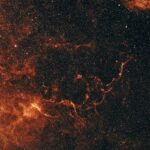Rare Solar Eclipse Creates Spectacular “Ring of Fire” Phenomenon
Overview
In a rare celestial event, an annular solar eclipse, also known as the “ring of fire,” mesmerized onlookers as it swept through the United States and Mexico. This remarkable event, characterized by a thin ring of light around the moon, was the last of its kind in the U.S. until 2039. The eclipse lasted for nearly two hours, starting from Oregon’s coast and traveling in a southeastern direction towards Texas. Although the full extent of the eclipse was only visible in a narrow line between Oregon and Texas, its partial effects could be witnessed throughout the U.S., Mexico, and most of Canada.
Key Facts
The annular solar eclipse occurs when the moon aligns directly between the Earth and the Sun but is at its farthest point from the Earth. This position causes the moon to appear smaller than a total solar eclipse, resulting in the iconic ring of fire effect. NASA estimates that about 70 million Americans had the opportunity to witness this eclipse as it crossed from the Pacific Northwest to Texas.
Viewing Recommendations
Experts recommend taking necessary precautions while viewing the solar eclipse. To ensure eye safety, NASA advises investing in a pair of eclipse glasses, which are significantly darker than ordinary sunglasses. Using regular sunglasses, binoculars, or observing the eclipse without any eye protection is strongly discouraged. Alternatively, viewers can observe the eclipse indirectly by creating a pinhole in a piece of paper, cardboard, or aluminum foil, and looking at the spot of light created by the hole.
Future Eclipses
While this recent solar eclipse concluded the series of annular eclipses until 2039, astronomy enthusiasts can look forward to another celestial spectacle next April. A total solar eclipse is projected to sweep through the U.S. on April 8, 2024. This eclipse, occurring when the moon is closer to Earth, will completely block out the sun and is expected to traverse a northeastern path, starting from Mexico and moving towards the Great Lakes states, Maine, and parts of Canada. Over 6.6 million Americans will have the opportunity to witness this total solar eclipse.
Editorial and Advice
The occurrence of a solar eclipse is a breathtaking reminder of the wonders of our universe. It provides us with an opportunity to contemplate our place in the vast cosmos and appreciate the beauty of natural phenomena. As humans, we must always remember the importance of protecting our sight while observing such events. The use of proper eye protection, such as eclipse glasses, is crucial in preventing ocular damage.
It is worth noting that the next total solar eclipse in April 2024 presents a unique chance for people in the U.S. and Canada to witness this remarkable celestial event. As excitement grows, preparations should be made regarding viewing locations, travel arrangements, and acquiring the necessary viewing equipment to fully appreciate the awe-inspiring event. It is advisable to be mindful of local weather conditions and be prepared to travel to locations with clear skies if necessary.
As the world continues to evolve, scientific understanding of eclipses and the cosmos will undoubtedly deepen. Embracing these rare astronomical events offers an opportunity for fascination, wonderment, and scientific exploration.
Australian sky-watchers are reminded to mark their calendars for the upcoming total solar eclipse in April 2024, taking the necessary precautions and ensuring that they have the appropriate viewing equipment. By doing so, they will be able to witness the power and beauty of nature, and perhaps gain a deeper appreciation for our place in the vastness of space.

<< photo by Arnaud Mariat >>
The image is for illustrative purposes only and does not depict the actual situation.
You might want to read !
- “Unveiling the Culinary Tapestry: Luke Nguyen’s Journey through Australia’s Rich Flavours and Spices”
- “Spectacular Super Blue Moon of 2023 to Illuminate Australian Skies”
- “Aussies Prepare for Spectacular Show: Super Blue Moon to Illuminate Australian Skies This Week”
- “Dazzling Celestial Spectacle: Catch the Breathtaking Peak of the Year’s Best Meteor Shower this Weekend!”
- How to Catch a Glimpse of the Spectacular Perseid Meteor Shower Down Under




